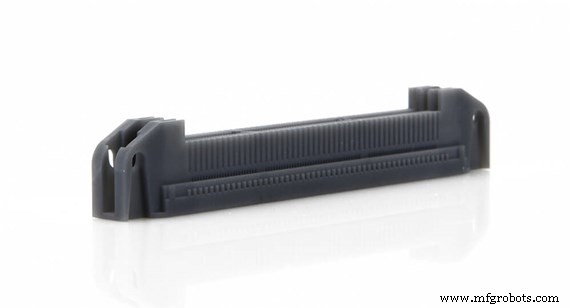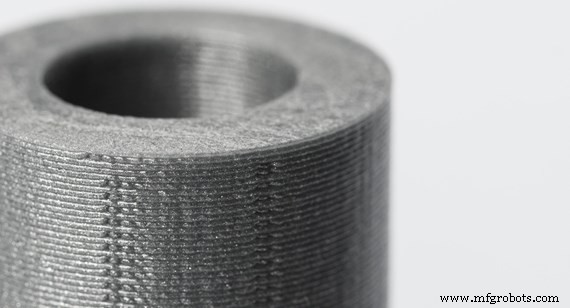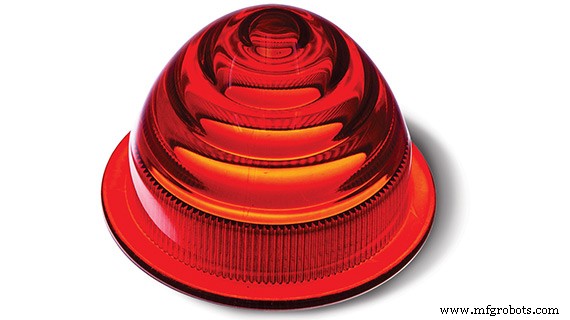Additive manufacturing, en met name modern 3D-printen, heeft een lange weg afgelegd sinds de eerste ontwikkeling in 1983. De 3D-geprinte onderdelen van vandaag kunnen een hoge resolutie en toleranties bereiken. Twee van de meer gebruikelijke technieken zijn stereolithografie (SLA) en fused deposition modeling (FDM). Hoewel beide in de jaren tachtig zijn ontstaan, gebruiken ze duidelijk verschillende manieren om onderdelen te maken, en als gevolg daarvan bieden de uiteindelijke onderdelen verschillende voordelen.

SLA-onderdelen gemaakt met Protolabs' MicroFine Gray™-hars bereiken een microprecisieresolutie.
Hoe werkt SLA?
SLA gebruikt fotopolymeerharsen als grondstof voor haar onderdelen. Fotopolymeren hebben intens ultraviolet licht van een laser nodig om uit te harden, en dat is het centrale idee achter SLA. De build vindt plaats op een platform ondergedompeld in hars. Een laser bevindt zich boven de tank en versmelt, geleid door precisiespiegels, de vloeibare hars en hardt deze uit om de gewenste vorm van het onderdeel te verkrijgen, laag voor laag. De ondersteunende structuren zijn de eerste lagen die worden gemaakt, zodat het onderdeel stevig aan het platform wordt bevestigd en voldoende wordt ondersteund. Bij elke passage breekt een recoaterblad de oppervlaktespanning van de hars boven het onderdeel. Het onderdeel wordt dan van onderaf opgebouwd.
Hoe werkt FDM?
FDM, een van de vroegste vormen van 3D-printen, is uitgevonden door een van de oprichters van Stratasys, Scott Crump. Het concept is eenvoudig:het lijkt veel op het gebruik van een heet lijmpistool. Een thermoplastische filament of spoel van plastic wordt verwarmd tot het smeltpunt. Het hete, vloeibare plastic komt via een mondstuk naar buiten om een dunne, enkele laag langs de X- en Y-as op het bouwplatform te creëren. De laag koelt en hardt snel uit. Naarmate elke laag is voltooid, wordt het platform neergelaten en wordt extra gesmolten plastic afgezet, waardoor het onderdeel verticaal groeit (langs de Z-as).
Materiaaleigenschappen van SLA en FDM
| Proces | Hoe het werkt | Kracht | Voltooien | Algemene materialen |
|---|
| SLA | Laseruitgehard fotopolymeer | 2.500-10.000 (psi)
17,2-68,9 (MPa) | Additieve lagen van 0,002-0,006 inch (0,051-0,152 mm) typisch | Thermoplastische fotopolymeren vergelijkbaar met ABS, pc en PP |
|---|
| FDM | Gefuseerde extrusies | 5.200-9.800 (psi)
35,9-67,6 (MPa) | Additieve lagen van 0,005-0,013 inch (0,127-0,330 mm) typisch | ABS, PC, PC/ABS, PPSU, PEEK, ULTEM |
|---|
 Op dit FDM-gedeelte zijn de laaglijnen zichtbaar. Foto:3Dhubs.com
Op dit FDM-gedeelte zijn de laaglijnen zichtbaar. Foto:3Dhubs.com
Neither of these techniques creates parts as strong as ones that are injection molded, for example, but they are suitable for rapid prototyping. SLA’s thin layers and strong bonding between the layers makes its parts smoother, with minimal striations along the Z axis, the direction of the build.
SLA Considerations
If details and surface smoothness are important for your part, SLA handily beats FDM. In part, because of its roots in laser technology, SLA parts can offer incredibly fine detail, yet pricing is competitive. Also, the SLA ultraviolet light curing process avoids FDM’s issues caused by heat compressing previously drawn layers. Equally important, SLA offers many additional finishing options, such as dyeing and texturing.
With SLA, there are three resolution levels from which to choose, ranging from 0.004 in. (0.1016mm) to 0.001 in. (0.0254mm) for layer thickness. Choosing one over the other not only affects part quality, but manufacturing time, too. Minimum feature size can be as small as 0.0025 in. (0.0635mm) on the XY plane and 0.008 in. (0.2032mm) on the Z axis.
One important issue with SLA parts is their sensitivity to light. As photopolymers, they can degrade from exposure to UV rays, such as sunlight. Adding a protective coating can slow this process.
MicroFine™ is an exclusive Protolabs material available in gray and green. This micro-resolution, ABS-like material can print layers that are extremely thin:just 0.001 in. (0.0254mm). That kind of precision is a prerequisite for building parts with many small feature details and is regularly used for small and highly accurate medical components.
FDM Considerations
FDM uses engineering-grade materials (see chart above) and offers a range of color options. With some FDM printers, parts can be as large as 427 in. x 153 in. x 172 in. (10,845.8mm x 3,886.2mm x 4,368.8mm). Essentially it depends on the size of the build space. Also, FDM parts are moderately priced, making it ideal for hobbyists, dental offices, and classrooms.
FDM’s tolerance is dependent on how the machine is set up, but can be as small as +/-0.0035 in. (+/-0.0015mm). Layer thickness varies based on the material you’re using, and some printers can print as thin as 0.001 in. (0.0254mm), although this would lead to long print times and may not be possible with larger parts.
Because temperature affects the core material, FDM parts are subject to rippled exterior edges caused as new layers are dropped atop previous layers. These Z-axis issues also cause weakness in the build. So, a part’s strength is entirely dependent on the direction in which it was built.
FDM does not do well with wide, flat areas, and has difficulties printing sharp corners, so adding fillets to your design makes sense. For all these reasons, prototyping with FDM works well when accuracy and surface finish aren't critical.
Although FDM gets the check for cost, SLA is quite competitive, especially for cosmetic prototypes with intricate designs. It’s also a go-to process to create forms for injection molding and casting.
When to Use SLA and FDM
With all of these considerations in mind, here is a list of when to use either method.
Use SLA :
For rapid, complex prototyping
When precision and a smooth surface finish is important
When high resolution, fine detail, and accuracy is necessary
For creating molds for casting to facilitate mass production
When strength and durability of the model is not crucial (models made from resin may suffer when exposed to the sun for long periods)
Use FDM :
For prototyping
When a selection of colors is needed
For low-cost models
When precision and surface finish aren’t crucial
For hobbyist and maker projects

SLA produced this clear, red taillight with a smooth finish and custom post-production painting.
For additional help, feel free to contact a Protolabs applications engineer at 877-479-3680 or [email protected]. To get your next design project started today, simply upload a 3D CAD model for an interactive quote within hours.
-
Prototyping met SLA versus FDM
De beste onderdelen worden niet toevallig gemaakt - ze zijn het product van urenlang testen en verfijnen van ontwerpen voordat de productie zelfs maar begint. Prototyping speelt een sleutelrol in het productontwerpproces en helpt ingenieurs mogelijke fouten of problemen in het ontwerp van een onderd
-
SLA vs. SLS:vergelijking van kunststof 3D-printtechnologieën
Het bepalen van welke van onze zes 3D-printtechnologieën u wilt gebruiken, is volledig afhankelijk van uw projectbehoeften, onderdeeltoepassingen, materiaalkeuze en algehele gewenste esthetiek. Twee van onze meest populaire 3D-printservices, stereolithografie (SLA) en selectieve lasersintering (SLS)
-
Wat zijn de verschillen tussen FDM en SLA 3D-printtechnologieën?
3D-printen is geen recente technologie zoals het lijkt, zo niet al vele jaren, sinds 1986 toen Chuck Hull , oprichter van 3D Systems, neemt de eerste 3D-printer op. Dit was een 3D SLA-printer (StereoLithoGraphy), die een hars gebruikt die stolt door fotopolymerisatie wanneer een laserstraal erop val
-
Herinneringen aan 3D-printen FDM
Sinds de RepRap- en Open Source-beweging in 2005 werd geboren met de komst van Dr. Adrian Bowyers 3D FDM-printer, die bijna volledig zelf kon worden gebouwd, is deze sector tot op de dag van vandaag sterk geëvolueerd. In dit artikel zullen we het hebben over 3D-printers en componenten die destijds c
 SLA-onderdelen gemaakt met Protolabs' MicroFine Gray™-hars bereiken een microprecisieresolutie.
SLA-onderdelen gemaakt met Protolabs' MicroFine Gray™-hars bereiken een microprecisieresolutie. 



 Op dit FDM-gedeelte zijn de laaglijnen zichtbaar. Foto:3Dhubs.com
Op dit FDM-gedeelte zijn de laaglijnen zichtbaar. Foto:3Dhubs.com 